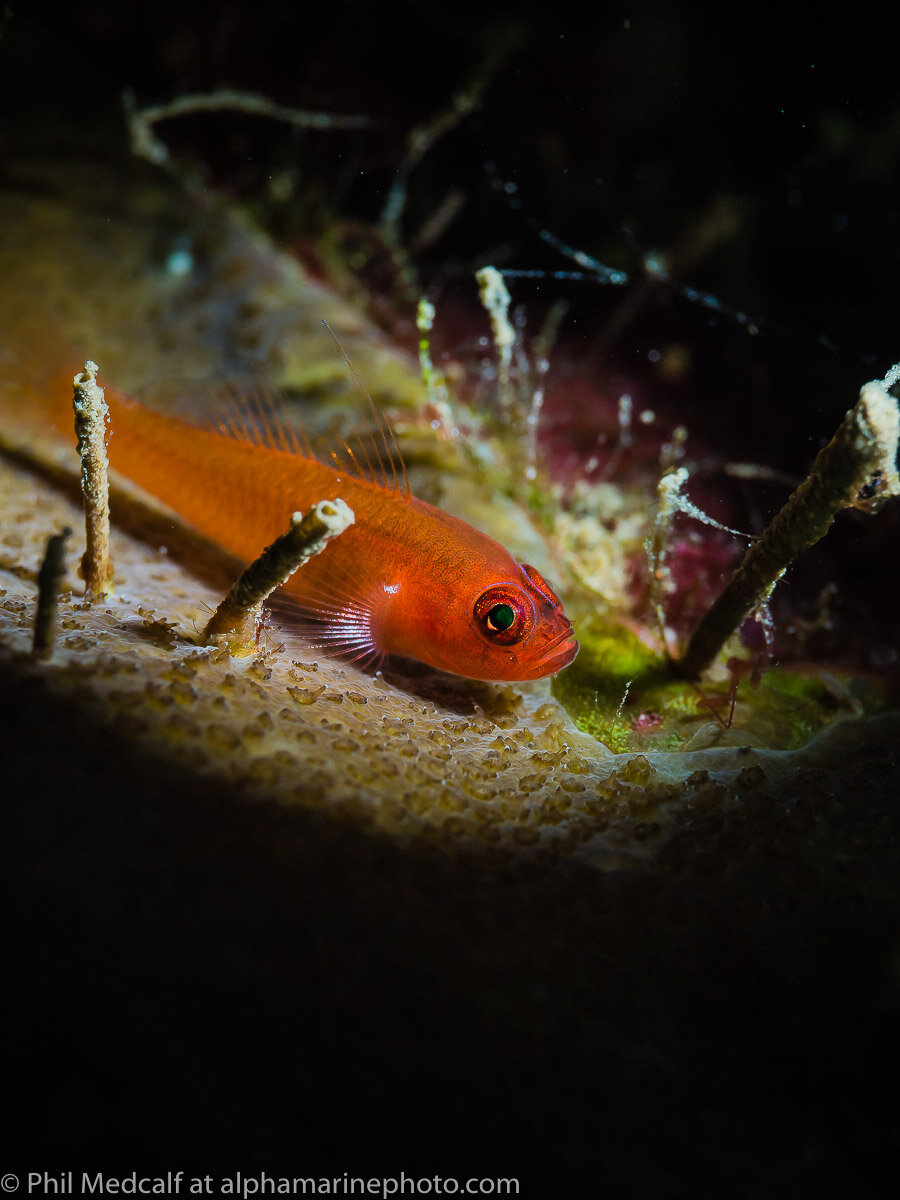Hope that subtitle doesn't attract the wrong sort of people!
Having a flash on your camera gives you a number of options beyond shooting available light which I discussed earlier in the blogs about Custom White Balance and shooting RAW.
The first option is to use the flash on the camera itself to illuminate your subject. Most housings for compact cameras and some housings for mirrorless cameras have windows to allow light from the flash out, they usually also come with a diffuser to soften and spread the flash light. With any flash you need to be close to the subject because the water will reduce the distance the light will travel making it much less effective than it would be in air.
This picture of a long spined scorpionfish/bullhead was taken by me in North Wales using a Fujifilm Finepix F30 camera in a Fuji housing. It was lit with built-in flash with a flash diffuser on the housing
You may also have to deal with shadows caused by the flash being close to the housing port. But even a small built in flash will give out more light in an instant burst than all but the most powerful video lights. While external strobes are more powerful, it's often the inability to change the position that the light comes from that puts the built in flash on a camera at a disadvantage. This said for conditions where available light isn't good enough to get the shot it's worth having a try with the built in flash if that is all you have to work with. A useful tip is that you'll often get more even lighting of your subject shooting portrait with the flash at the top than when shooting landscape.
Here's an image of a Spotted Moray (Gymnothorax moringa) taken using built-in flash by me in Bonaire, this time using the Canon S95 in a Canon underwater housing.
The second option puts a camera with a flash (or a hotshoe) even further ahead of the action cameras by allowing you to trigger a strobe.
Before we go further let's clarify this. A strobe is the name given by underwater photographers to a separate flash designed for underwater photography.
An INON S2000 strobe, is a small but quite powerful underwater flash that can be trigger using the flash on your camera.
Having a strobe when combined with an good arm system to mount it on gives you a positionable light source that has more coverage and power than a built-in flash. This instant burst of light allows you to illuminate the foreground of your images while using your shutter speed to control the lighting of the background in your image.
This image was taken using two strobes to evenly light the red sponge and surronding soft corals in the foreground while the exposure of the background was controlled by setting the camera manually. The artificial light has brought out the red of the sponge that in the ambient light looked more dull.
If you use video lights you have to adjust your camera settings to control the exposure of the whole image which means that ISO's are often raised, shutter speeds slower and apertures wider. This contributes to why images taken with video lights rarely appear as sharp and crisp as those taken with strobes.
A pair of strobes isn't necessary for all types of underwater photography. You can get good results using a single strobe especially in macro photography where one strobe gives a lot of scope for different techniques.
The image below was taken using a single strobe fitted with a device called a snoot to narrow the light to a small area.
Strobes can be triggered in a number of ways. The most popular now is using a fibre optic cable to carry the light from a camera’s flash to the sensor on the strobe. With cameras that have a hotshoe either instead of or as well as a built in flash, electronic cable connection is another option. This does limit which strobes can be used and means that a connection has to run through a port on the housing but means that you don't have to use battery power firing a flash to trigger a strobe. It is now possible to buy strobe triggers that connect to the camera hotshoe and produce a flash of light by LED to allow fibre optic cables to be used without a built in flash and this also reduces camera battery consumption.
Using strobes is a big subject and I'll cover it more in a separate set of blogs in the future. If you'd like advice or are interesting in buying equipment or booking on one of our workshops get in touch via our email info@alphamarinephoto.com or join our Q and A group on Facebook. If you found this blog useful and would like to support us you can ‘buy me a coffee’.
Be aware links to Wex, MPB or eBay listings are affiliate links and we get a small percentage if you buy something through them.






